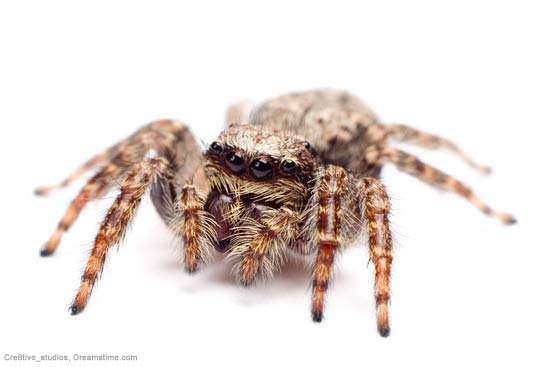Killer Spiders Prefer Malaria Mosquitoes

A jumping spider in East Africa is known to crave mosquitoes engorged with blood. Now scientists find the spider prefers a particular type of them—mosquitoes infested with the deadly malaria parasite.
These predatory spiders could help control the lethal disease, scientists say. Malaria leads to more than one million deaths per year worldwide, mostly children.
"My dream would be that people could be educated to recognize this little animal and not kill it when found inside houses, as it often is, apparently in search of food," behavioral ecologist Ximena Nelson at Macquarie University in Sydney, Australia, told LiveScience. "If these spiders are left in these houses, they may diminish the number of blood-fed mosquitoes leaving the house, and thus prevent someone else from becoming infected."
Big jumpers
Nelson and colleague Robert Jackson at the University of Canterbury in Christchurch, New Zealand, investigated the jumping spider Evarcha culicivora. This predator dwells near Lake Victoria, Africa's largest lake.
Jumping spiders are known for leaping anywhere from 10 to 40 times their own body length—which would mean up to 220 feet for a 5-foot-6-inch tall person. The spiders also have keen eyesight, capable of making out details 40 body-lengths away.
In past research, the scientists discovered E. culicivora consistently preferred female mosquitoes that had recently finished a blood meal. The spiders targeted bloodsuckers over non-biting midges (by far the dominant mosquito-sized insect in these habitats), male mosquitoes (which do not suck blood), and female mosquitoes that were fed sugar.
Sign up for the Live Science daily newsletter now
Get the world’s most fascinating discoveries delivered straight to your inbox.
"Robert Jackson is a great naturalist. He noticed these 5-millimeter spiders inside houses attacking mosquitoes when there seemed to be an overabundance of midges that could have been attacked," Nelson said.
The region where these spiders live is one where the impact of malaria is especially severe, even by African standards. Nelson and Jackson therefore investigated whether E. culicivora singled out Anopheles mosquitoes, the carriers of the malaria parasite, over Culex mosquitoes, which do not harbor the germ.
Suffering scientist
Nelson's research was complicated by side effects from the antimalarial drugs she took. "Work definitely slowed down with this as I became rather forgetful, and even had to write down what experiment I was running at the time," she said. Moreover, "field work had to be very early or late in the evening as it was too hot for us, not being hardy locals."
The researchers took advantage of the exceptional vision of the spiders and tested them with virtual prey depicted with animated 3-D drawings [graphic]. The spiders were placed on top of an inclined metal ramp oriented toward virtual mosquitoes projected in front of them onto a screen.
The scientists also used motionless lures made from dead prey mounted on cork disks in lifelike postures. Anopheles mosquitoes adopt a distinctive posture when they rest, angling their abdomens away from whatever surface they are on. Younger spiders, which are not yet large enough to tackle the mosquitoes, take advantage of the Anopheles posture by moving behind and under the mosquito's abdomen and then attacking from below.
Nelson and Jackson discovered the jumping spiders preferred to stalk or leap onto both virtual and dummy Anopheles over Culex mosquitoes, even when starving. This is the first time any predator was shown to single out Anopheles as their preferred prey.
"That they can do this based on vision alone when it is hard for human eyes to be able to distinguish this level of detail was, for me, the most surprising finding of this aspect of the work," Nelson said.
The scientists reported their findings in a recent issue of the journal PLoS ONE.
- Secret Weapons: A Bug's Arsenal
- Backyard Bugs: The Best of Your Images
- Images: Creepy Spiders










